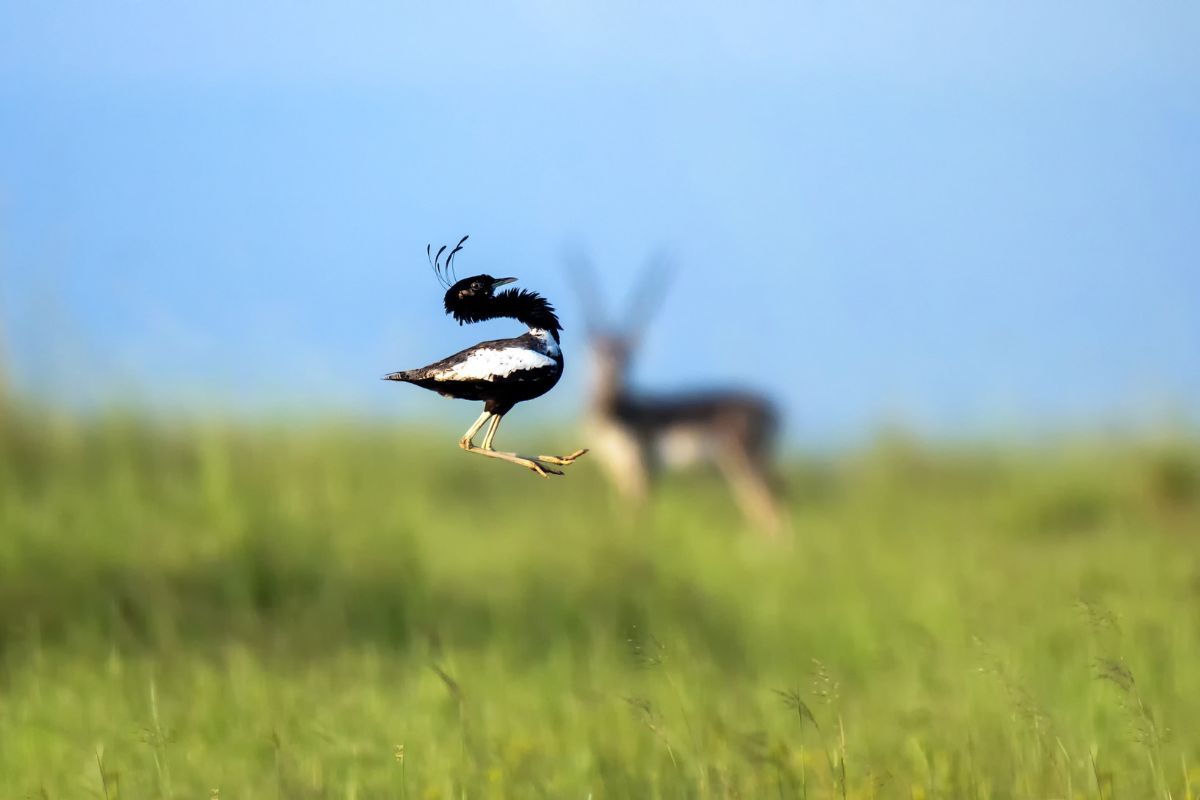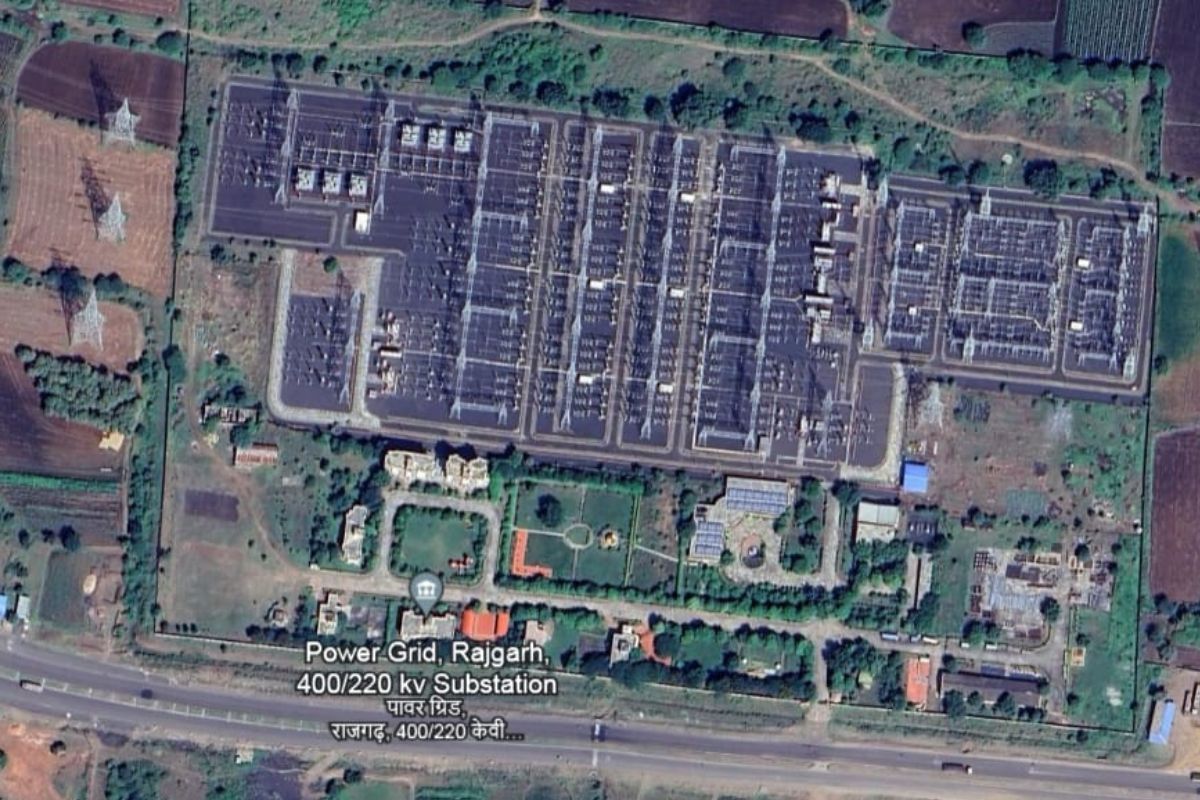The Kharmor, also known as Lesser Florican or Bhaat Kukda, is a unique bird belonging to the Bustard Family. Recognizable by its beautiful crest and frog-like calls, it’s known for its remarkable ability to jump 2-3 meters high repeatedly. This smallest member of India’s Bustard species migrates annually to Madhya Pradesh, Rajasthan, Gujarat, and Maharashtra for breeding.
Kharmors play a crucial role in grassland ecosystems and agriculture. They consume insects that damage crops like moong and urad, making them valuable allies to farmers. However, their population has declined dramatically in recent years.
In 2021, the International Union for Conservation of Nature (IUCN) classified the Kharmor as critically endangered. A 2020 study by the Bombay Natural History Society (BNHS) revealed only 340 male Kharmors remain in India, with a global population of about 1000.
Conservation efforts are vital to protect this unique species and maintain the delicate balance of grassland ecosystems they inhabit.
What accounts for their extinction?
Experts provide numerous explanations for the ongoing decline in the population of Kharmor. However, the inconsistent policies implemented by the forest department officials in Madhya Pradesh have contributed to a persistent decrease in this bird’s numbers within the state, resulting in sightings being restricted to just one or two individuals annually.
This explains why, despite the existence of two sanctuaries (Sailana Kharmor and Sardarpur sanctuaries) dedicated to the conservation of Kharmor in Madhya Pradesh, the ongoing conservation efforts haven’t achieved the desired success.

The most recent information available from the forest department indicates that 11 Kharmor were observed in the Sailana Kharmor and Sardarpur sanctuaries of Madhya Pradesh in 2019. Subsequently, their numbers declined, reaching zero over the past two years.
In 2015, the figure stood at 48, whereas in the subsequent years, it recorded 39 in 2016, 19 in 2017, and 27 in 2018.
Environmentalist Ajay Gadikar, contributor to the Wildlife Institute of India’s 2017 Status Report on Kharmor birds, identifies several factors behind their declining population:
1. Grassland habitat degradation
2. Changes in agricultural practices
3. Pesticide use
4. Windmill proliferation in Madhya Pradesh
5. Anthropogenic pressures
6. Local farmers’ assertive stance
These findings align with the Ministry of Environment’s 2018-2019 report on protected area management.
Gadikar also questions the forest department’s methods, particularly regarding the Sailana sanctuary (established 1983). “The failure to acquire local residents’ land within the sanctuary boundaries has led to significant losses for farmers, fostering a sense of inadequacy.”
Addressing these complex issues is crucial for the Kharmor’s conservation and the well-being of local communities.
Windmills near Sailana Bird Sanctuary
The Sailana sanctuary and its adjacent regions are classified as an eco-sensitive zone, prohibiting industrial activities and the installation of windmills within a 10 km radius of the sanctuary’s boundary. By this regulation, the government of Madhya Pradesh declined to sanction a wind power project in 2017.
Despite this, approximately 50 windmills continue to function within the eco-sensitive zone of Sailana, and the central government acknowledged in the 2020 notification that 15 wind power plants are active in the same area.

Ajay Gadikar addresses the implications of windmill installations within the eco-sensitive area surrounding the Sailana Sanctuary on the Kharmor bird population.
“In the past three to four years, these elevated wind turbines have been strategically positioned within the eco-sensitive area that delineates the boundaries of all three sections of the sanctuary. The auditory disturbances generated by these windmills further elevate the likelihood of the Kharmor bird experiencing fright and subsequent displacement.”
Concurrently, the Biodiversity Report compiled for the National Highway constructed under the Bharatmala Project in the Sailana Sanctuary region has indicated that sound instils fear in the Kharmor bird and significantly increases the likelihood of its displacement. Consequently, a soundproof wall has been built in the designated region of the National Highway to preserve the soundproofing condition of the Sailana and Sardarpur Sanctuary.
In the context of the Standing Committee established for the denotification of sanctuary land, which convened during the National Board for Wildlife meeting, the submitted report indicated that local forest officials and staff expressed concerns regarding wind power plants functioning without official authorization in the eco-sensitive zone.
They noted that such operations were deterring the Kharmors from accessing the area during their breeding season. A comprehensive framework ought to be established for the safeguarding of protected areas and ecologically sensitive zones.
The energy produced by these facilities is transmitted via electrical conduits to the distribution point located in Nagra village, which is situated 30 kilometres from this point. The elevation of this high-tension line corresponds to the maximum altitude at which Kharmor or Bustard birds are capable of flying.
During the meeting of the National Board for Wildlife, Kishore Rithe, a board member and director of the Bombay Natural History Society, proposed that the power line leading to the sanctuary area be placed underground.
Despite his recommendation, the forest department permitted the setting up of 41 towers for a 220 KV power transmission line spreading the 45.479-hectare eco-sensitive zone of the Sardarpur sanctuary, raising concerns about environmental implications.
No measures have been carried out
Taking a dig at the working style of the forest department, social activist Akshay Bhandari of Dhar district says,
“Work on the Indore-Dahod rail line connecting tribal districts has been stalled due to the Kharmor bird sanctuary in the Sardarpur area of the Dhar district. If the department was concerned about Kharmor, it would not have sanctioned the power grid in the eco-sensitive zone of Kharmor Sanctuary in 2002-2003.”
“The forest department is not giving clearance to an important project like the railway line because of the Kharmor bird, while Kharmor has not been seen in this area for a long time,” he alleged.

On the other hand, Railway PRO Khemraj Meena told Ground Report that
“plans have been made to bypass the railway line near Sardarpur century. The objection of the Union Ministry of Forest and Environment has been resolved, and the approval has been received from the Regional Office of the Forest Department and now the approval of the Center is awaited.”
The farmer’s ally, Kharmor, has now become an adversary
Chandel, a local resident of Gumanpura village, which falls in the eco-sensitive zone of the Sardarpur sanctuary, says that
“the forest department has not allowed farming for years because of the Kharmor, while the Kharmor has not been seen for the last two to three years.”
The proposal to set up a bird sanctuary in Madhya Pradesh was made in 1980 by Salim Ali, an ornithologist with the Bombay Natural History Society.
Acting on his proposal, the state government created bird sanctuaries at Sardarpur in Dhar district and Sailana in Ratlam district in 1983. Both the sanctuaries (Sailana and Sardarpur) were notified, and then the land of the local people was also notified under the purview of the sanctuary. Since then, the government has neither acquired their lands nor paid them any compensation, and even the purchase and return of their lands has been stopped.
Chandel said,
“Because of this, we have been suffering from the harassment of the forest department for years; we cannot even dig wells, tube wells, or hand pumps on our own land. For this, also the approval of the forest department has to be obtained.”
The farmers and villagers demanded the administration shift them from the sanctuary area. In the year 2021, a letter was written to denotify two parts of Sailana Sanctuary of 355 hectares and 90 hectares, while 34812.177 hectares of land of about 14 villages from Sardarpur Sanctuary was demanded to be taken out of the sanctuary area.
Sailana’s, Vasu, says that “some of his land is in the reserve area. He can neither cultivate this land nor sell it.”
Though some portions of land in Sailana have been denotified, the Sardarpur sanctuary case is still on paper.
On this subject, Dr. Sujit Narvade associated with the conservation of Bustard and Florican says that,
“The current conflict stems from the government’s failure to properly acquire and compensate for sanctuary lands. Farmers, burdened by years of restrictions without recompense, have developed resentment towards the sanctuary and Kharmor birds. This negative sentiment undermines conservation efforts, highlighting the need for equitable solutions.”
He further says that
“Apart from denotifying some land of the Sailana sanctuary, an area of about 1394.161 hectares has been notified. This newly notified area is also not suitable for the conservation of Kharmor. because along with windmills, the increasing number of Nilgai here is also a big problem.”
Conservation is not possible without collective efforts
In 2005, the team of Supriya Jhunjhunwala, Anirban Dutta, and Gargi Deshmukh worked with the forest department to conserve the Lesser Florican by preserving the grassland in Sailana Sanctuary.
Community participation was used in this project. Under this, award programs, films, music videos, posters, and books were resorted to make the villagers, farmers, and children aware of Lesser Florican.
Anirban Dutta, who was associated with the project, says,
“As a result of these efforts, the number of birds coming to Silana during the monsoon season has almost increased. In the year 2008, 40 Kharmor were seen in Sailana; before the project, their number was only 27. Because of the success of this project, our team has twice received the Conservation Leadership Program Award.”
Samita Ranjaura, PCCF, Forest Department, who was associated with the project in 2008, says,
“The way the work has been done in Sailana from 2005 to 2009 if the job is done in the same way, then the chances of success in the conservation efforts of Kharmor will be higher.”
PC Dubey, who retired from the post of Principal Chief Conservator of Forests PCCF in 2020 and worked for a long time to save the Kharmor in the state, also says,
“Kharmor conservation requires local community involvement. Government should incentivize protection by relaxing regulations for residents in Kharmor habitats.”
The breeding centre is limited to paper
The MP forest department has planned protected breeding in view of the steadily decreasing number of Kharmor. Even after the lapse of two years, the proposal for this scheme has not been prepared, despite the fact that the cooperation of the Salim Ali Centre for Ornithology and Natural Sciences (SACON) was sought for this scheme.
Santosh Kumar Ranshore, Superintendent, Kharmor Sanctuary, Sardarpur, says,
“In view of the ever-decreasing number of Kharmor, a project has been prepared for the arrangement of protected breeding or conservation breeding; a booklet has also been prepared for this, but the proposal of the project has not yet been sent to the Forest Department, Headquarters. Soon the proposal of this plan will be prepared and sent to Headquarters for approval, after which the process of getting approval from the Center will be done.”
What’s next?
The movement of Kharmor is being monitored through telemetry project. Their movement is monitored by placing a device on Kharmor’s body. Ajay Gadkar said,
“After the harvest, the Kharmor birds move to other areas, but these birds first go to Ajmer, then Madhya Pradesh and Maharashtra.”
He further said, “The more information we get about this bird, the more it will help in its conservation. More research is needed toward this.”
At the same time, Sujit also supports his point, saying,
“In particular, there is a need to assess the damage caused to Kharmour by windmills operating around the sanctuary in Madhya Pradesh.”
On the other hand, Bombay Natural History Society’s director Kishore Rithe says,
“More efforts will have to be made for conservation. Only then will we see a change in the situation.”
Support us to keep independent environmental journalism alive in India.
Keep Reading
Govt shelves elephant census, population drops 20% in 5 years
Wildlife SOS mourns passing of Suzy, 74, oldest rescued Elephant
Asian Elephants display complex mourning rituals similar to humans: study
Asian Elephant populations threatened by rapid ecosystem decline
Follow Ground Report on X, Instagram and Facebook for environmental and underreported stories from the margins. Give us feedback on our email id greport2018@gmail.com.
Don’t forget to Subscribe to our weekly newsletter, Join our community on WhatsApp, and Follow our YouTube Channel for video stories.








